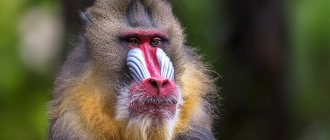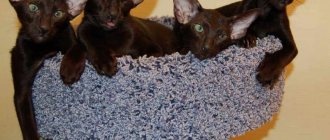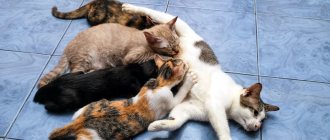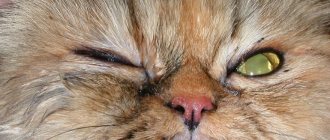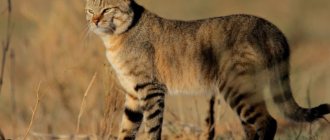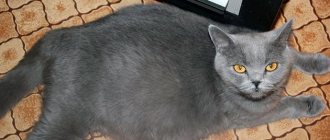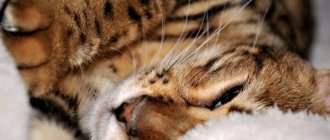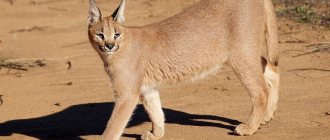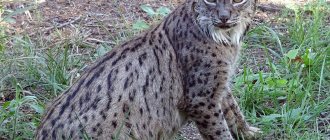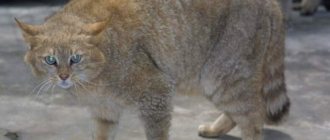- Posted by Olga Arkhipova
- Date: March 21, 2018
Caracals are predators of the cat family, distinguished by long black tufts on their ears. These are very capricious and demanding animals. However, with proper care and caring attitude, desert cats will become loyal and devoted friends to their owners.
- 2 Where does the caracal live
2.1 Video: caracal
- 3.1 Video: caracal hunting
- 4.1 Video: caracal at home
Description of caracal
From the description of the breed it is clear that the desert cat Caracal is similar to a lynx in some features: ears with tassels, round pupils, large limbs, and a muscular body.
Otherwise, she looks like an exceptional individual:
- Folding graceful body measuring 65–85 cm in length. Height at withers 40–45 cm.
- A long tail.
- Small head.
- Elongated muzzle. There are black eyeliners around the eyes and also on the cheeks.
- Large dark nose with a pink mark in the middle.
- Protruding black ears 4–5 cm high with black crescent-shaped tassels. The inside of the ears is “trimmed” with white edging.
- Long massive limbs.
- Short six medium firmness.
The desert lynx has a monochromatic sand color with a red or brownish tint. The belly, neck and chin are painted white.
The weight of an adult animal can vary between 12–18 kg.
Scientific classification
- Kingdom: Animalia (animals)
- Phylum: Chordata
- Class: Mammalia (mammals)
- Order: Carnivora (predatory)
- Family: Felidae (felines)
- Genus: Caracal (caracals)
- Species: Caracal caracal (caracal)
Buffon in 1761 chose the name "caracal" in connection with the Turkic name for the animal "karrah-kulak" or "kara-kulak", which means a cat with black ears . In Afrikaans (an African language, a dialect of Dutch), this cat is called “rooikat” - “red cat”. Other names for caracal: African lynx, desert or steppe lynx.
Interesting facts about the breed
There are a lot of interesting facts about this cat breed:
The caracal is a very fast and agile predator; it is very similar in appearance to a lynx, but has a longer tail; During the hunt, the animal behaves very carefully and quietly. The caracal can growl like a leopard, and if it is caught near its prey, it hisses and growls like an ordinary domestic cat; the animal has good eyesight and sensitive hearing, thanks to which it is an excellent night hunter in the wild; in nature they live alone, and sit in their homes for a long time; The caracal cat raises its offspring on its own
Before giving birth, she manages to make several secluded places to live; in the wild, cats need long tufts on their ears for camouflage; An animal's ears laid back indicate a threat. Straight ears indicate that the animal is in a good mood and listens carefully to its owner; when meeting with their representatives of the genus, steppe cats communicate using ear movements; cats are excellent climbers and jumpers in trees, and can easily jump to a height of more than 2 meters; caracals cannot run for long because of their long limbs, so they hunt by jumping; The life expectancy of a steppe cat in the wild is 10-15 years.
In conclusion, it is worth noting that with the purchase of a caracal kitten, positive emotions and good mood will appear in your life. This pet knows how to be grateful. He loves to spend his leisure time with his owners, playing games or just sitting on their laps. This domestic steppe lynx will bring variety and a lot of pleasant and positive moments into the life of its owners.
Owner reviews
According to experienced steppe lynx breeders, a private country house with an attached special enclosure is best suited for keeping a wild cat. The standard area of such an enclosure should be at least 15-16 m2. The room needs to be equipped with special steps, shelves for jumping, as well as a scratching post in the form of a log or wooden block covered with hemp twine.
Important! Raising a domestic caracal should begin from early childhood. In its behavior during play, the steppe lynx resembles a dog. Even small caracals love to run after different objects and bring them to their owner.
For games, it is recommended to purchase durable and reliable toys made from natural and durable materials . The animal easily gets used to the leash and collar, caresses and purrs like an ordinary domestic cat. If necessary, the steppe lynx gets used to using a toilet in the form of a tray well and quickly.
The domestic caracal is very vindictive and remembers rude treatment or physical punishment well. In retaliation, the animal may scratch or bite the owner, as well as ruin all the furniture in the house. If you do not have confidence in your own abilities, then it is recommended to involve professionals for training, who will instill in the wild cat the full range of necessary skills and quickly socialize the animal.
An amazingly beautiful animal, a predator from the cat family, the steppe lynx - Caracal. For a long time, the caracal was considered a type of lynx, as there are some external similarities. But due to a certain set of genetic differences, this cat began to be considered as a completely separate species.
Features of keeping a wild cat at home
Representatives of this breed require the same care as other pets. In order for a pet to be healthy and cheerful, it needs to be properly fed, raised, carry out certain hygiene procedures, and carry out preventive veterinary examinations in a timely manner. In order to prevent serious health problems for the caracal, it is first recommended to find out what diseases this animal is susceptible to.
What to feed your pet?
It is recommended to feed the caracal natural food. Meat should predominate in his diet. Occasionally, a cat can be pampered with premium dry food designed for feeding Maine Coons or representatives of the Norwegian breed. The bowl should contain exactly as much food as your pet can eat at one time. It is not allowed to leave uneaten food. It is advisable to give the animal live rats and mice.
Until the cat reaches 3 years of age, the diet should contain vitamin complexes and calcium supplements. Food should be at room temperature. It should be prepared immediately before feeding. Every 10 days, the pet should be given fasting days, which involve complete abstinence from food for 24 hours. Kittens and cats expecting offspring are freed from fasting. Information on how to properly feed such a pet at home is presented in the table:
| Pet age | Daily feeding frequency, times | Products | |
| Allowed | Prohibited | ||
| Kittens | 2 |
|
|
| Adults | 1 |
How to raise a cat?
These animals do not need special training. They are easy to train and quickly adapt to the rules in their new home. Toilet training will not cause any difficulties. A smart cat will guess what purpose this device serves.
Caracal requires a strict, but fair and affectionate attitude. He does not tolerate raising his voice or physical humiliation. Indecent behavior of a pet must be stopped quickly. You should not allow a kitten to climb onto the dining table or damage household shoes and furniture. It is recommended to remove fragile and valuable objects, as well as poisonous indoor plants, from the animal’s field of view.
These cats love walks. They need to be walked on a harness away from dog walking areas. It is prohibited for a pet to be left without a leash outside an enclosed space.
If there are no plans to breed these animals, it is recommended to sterilize them. A sexually mature individual, whether male or female, actively marks its territory. In this case, the animal’s behavior becomes unpredictable, even aggressive.
What to pay attention to in terms of health?
Representatives of this breed have good health and strong immunity. With proper nutrition, they can easily tolerate diseases such as plague, influenza, and other diseases of a viral and bacterial nature. When keeping a caracal at home, you need to take into account that feeding pork can lead to dire consequences, namely the development of Aujeszky's syndrome, which manifests itself in the form of nervous system dysfunction and skin itching.
To maintain your pet's health at the proper level, it is recommended to regularly vaccinate and deworm it. Proper care, information about which is provided in the table below, also helps strengthen the animal’s body’s defenses.
| Hygiene procedures | Multiplicity of execution | Note |
| the washing up | Only in case of contamination | For bathing, you need to use hypoallergenic cat shampoo. |
| Combing | Weekly | Brush the cat with a rubber brush. During molting, this should be done daily. |
| Nail trimming | As it grows | To sharpen your claws yourself, it is recommended to purchase a scratching post. It is better to remove claws on the front paws using a laser. |
| Eye cleansing | As it gets dirty | Cleaning is carried out with a cotton pad soaked in warm boiled water. |
| Ear cleaning |
Top articles: Facts about ladybugs
Character and behavioral characteristics
When purchasing, it is worth remembering that Caracal cats are predators. Therefore, a lot of attention is paid to raising kittens. The main principles in their upbringing are consistency and subordination. The pet owner must clearly state his conditions, showing who is boss in the house.
The Caracal cats themselves are different:
- phlegmatic calm;
- good nature;
- passion for games of various types;
- owner's instinct. This animal gets along well with other pets (cats, dogs), but is aggressive towards other people’s animals and will drive them out of its territory;
- curiosity. Hearing footsteps outside the door, the animal will immediately rush towards them to see who has come. Also, during a walk, hearing a rustling in the bushes, the cat will show interest.
Despite its formidable appearance, this breed has a soft and docile character. Pets love to be scratched behind the ears, stroked, and simply cannot stand being alone. In other words, the domestic caracal requires increased attention.
How to protect yourself from enemies
In the wild, the steppe lynx actively defends itself from its enemies (steppe wolves). But domesticated individuals are more peaceful, and they have practically no self-defense instincts. Of course, if you seriously offend a cat, he may bare his teeth or scratch.
What does it eat in natural conditions?
Under natural conditions, steppe cats eat: rodents (gerbils, jerboas, gophers), hares. Sometimes they are not averse to eating hedgehogs, insects, reptiles and even porcupines. In addition, caracals also feed on plant foods: grass, grapes. They may not drink water for several days in their natural habitat, being content with the amount of liquid they get from food.
Lifestyle
Photo: Christiaan Viljoen
Although the caracal is primarily nocturnal , activity levels are bimodal and dependent on ambient temperature rather than photoperiod. Travel speed usually increases at night. This predator prefers temperatures below 20 °C, and daytime activity increases on cool, cloudy days. Males move 5-15 km daily, and females move 2.5-10 km per day.
The caracal prefers solitude , and only occasionally are the movements of two adults or females accompanied by their offspring observed.
Males exhibit throwing behavior by moving their paws across wet sand after urinating, or mark by raising their tail vertically and spraying urine onto vegetation and logs around their territory. Females also exhibit throwing behavior, although not as frequently as males. Both sexes use "tree scratches" to mark their territories.
Caracal lifestyle and nutrition
Caracal is a resident of arid regions. Its habitat is lowland shrub deserts and sandy deserts, clay deserts and semi-deserts. Caracals can also be found in steppes and savannas, foothills and hilly areas. He can go without water for many days; the liquid contained in his food is enough for him. The caracal spends the hottest part of the day in the shade of rocky ledges or bushes.
The caracal hunts at dusk and at night. Asian subspecies of caracal often go fishing during the day. The caracal actively searches for and pursues prey. However, he cannot run for long. Therefore, it hunts not by stealing, but by concealing the prey and overtakes it with large jumps, up to 4.5 meters in length. During the hunt, the caracal tries to sneak up to the prey as unnoticed and as close as possible. Moreover, you will never see the desert lynx itself; only its black ears with tassels stick out. The caracal has excellent hearing. Many zoologists who have studied the life of the caracal both in the zoo and in nature are convinced that the ears of the desert lynx are natural locators, and the protruding tassels are antennas, thanks to which the desert lynx has excellent orientation at any time of the day. Having crept close to the prey, the caracal jumps into the very thick of the flock with springy leaps, and with sharp blows of its paws knocks down the fluttering birds. But its main food is rodents (jerboas, gerbils, gophers), small antelopes, and tolai hares. Sometimes it preys on porcupines, hedgehogs, insects, reptiles and small predators. It also eats plant matter. Having settled near an oasis, the caracal can attack lambs and kidnap poultry. Like a leopard, it drags its prey up a tree and eats it there.
Uses porcupine and fox burrows as shelter. A caracal can use one hole for several years. In spring, the desert lynx rests in the bushes.
The caracal is an excellent climber on trees and various vertical surfaces. If a caracal is cornered, it actively defends itself, in which case it can even be dangerous to humans.
Except for the breeding season, representatives of this species lead a solitary lifestyle.
What does it eat?
As mentioned above, the caracal is not too picky about food. He is ready to eat almost any prey that he can catch and kill
Therefore, quite often its diet consists of various rodents - gophers, jerboas and gerbils. In some cases, tolai hares may become victims. And if you’re lucky, the caracal can easily cope with small antelopes or goitered gazelles that have strayed from the herd.
However, the diet often includes more exotic prey. For example, caracals do not disdain hedgehogs and reptiles. If there is no prey for a long time, they may well feast on insects. In regions where such prey lives, it may attack a mongoose or a young ostrich.
But caracals do not feed on carrion - the too pungent smell emanating from rotten meat permeates the dense skin of the predator and may well play a bad joke during an ambush hunt. Although, if fresh remains from the recent food of another predator come across, the caracal will not demonstrate excessive disgust.
Where can I buy a kitten and how much does it cost?
Those who decide to have caracal kittens inevitably have the question of where to buy them and what their cost is. The official breeding and sale of these cats is carried out by specialized nurseries. They come in home and aviary types. You should not buy caracals for keeping at home. Firstly, keeping these animals at home without the necessary documents is prohibited, otherwise they are subject to confiscation. Secondly, a kitten acquired in this way may turn out to be sick.
It is recommended to buy kittens after they are 5–6 months old. Before buying a baby, you need to carefully examine and observe its behavior. Healthy individuals are active and have a smooth coat. On average, kittens of this breed cost about 650 thousand rubles.
History of the origin of the breed
The Caracal cat breed originated in ancient times. It was believed that hunters from Africa and Central Asia went out hunting, taking a wild cat as a companion. And while wealthier people could afford cheetahs, the caracal was considered a more economical option. By the way, even today in many areas people among themselves call these animals “cheetahs for the poor.”
At the same time, the hunting instincts of caracals have always been at their best. Such cats could catch a pheasant, peacocks, a hare or even an antelope. Currently, caracals mostly live in the wild. There really aren’t that many domesticated purrs.
The breed was recognized as a domestic caracal only in the 20th century. It was then that he entered Europe. Recently, this breed has been officially recognized by all felinological organizations and has certain standards.
Varieties
There are 9 subspecies of caracal:
- West African caracal (Caracal caracal poecilictis) - found in Central and Western Africa, Senegal, Nigeria;
- Indian caracal (Caracal caracal schmitzi) - lives in Western Asia, Iran, Saudi Arabia and India;
- common caracal (Caracal caracal caracal) - found in Central and Southern Africa;
- Gabonese caracal (Caracal caracal lucani) – found in Gabon, Congo, Angola;
- Namibian caracal (Caracal caracal damarensis) – lives in Namibia;
- North African caracal (Caracal caracal algira) – lives in North Africa;
- Nubian caracal (Caracal caracal nubica) - found in Ethiopia and Sudan;
- Transvaal caracal (Caracal caracal limpoensis) - found in Botswana and northern South Africa;
- Turkmen caracal (Caracal caracal michaelis) – lives in Turkmenistan.
Character
In fact, a domesticated caracal is no different from an ordinary cat. Well, maybe it weighs 15-20 kilograms. But their character is very similar. It largely depends on the habits of the owners and their attitude. With plenty of feeding, proper care and affectionate treatment, the caracal becomes a very friendly, loyal and calm pet.
As a rule, people who accuse them of cruelty and unsociability are themselves to blame - they scare away the beast with shouts, threats, beatings, or make other serious mistakes.
Best articles: What is the epicenter of an earthquake?
If everything is done correctly, the caracal will become a curious and playful pet; it will be happy to play with domestic cats and dogs, not to mention children. True, you still need to be careful here - this is a serious predator with sharp claws and long fangs. A playful or angry animal may well accidentally cause pain to people or other animals. However, like any cat, only taking into account the difference in size.
And, of course, you need to immediately outline the boundaries of what is permitted. Feed in a certain place, do not allow the kitten to play with the owners’ things, and do not let the kitten sleep in the bed. It’s unlikely that anyone will want to share a bed with a twenty-kilogram cat in six months or a year.
The right diet
A very important aspect in keeping an unusual pet is the caracal’s nutrition. Fortunately, you won’t need too complex or exotic products here.
The domesticated caracal happily eats almost any meat product. For example, he does not refuse rabbits, gophers and other rodents. He enjoys eating beef and chicken, including boiled chicken. It would be a good idea to include fish in your diet - sea fish can be given raw, but freshwater fish must be cooked to ensure that the eggs of parasites are destroyed.
Also, do not forget to give your pet minerals and vitamins. You can dissolve them in water or simply mix them with meat.
But it is not advisable to feed a caracal pork. Fatty meat can lead to serious obesity - the animal moves little and may develop health problems over time.
Animal health
The health of domestic lynx is usually excellent. Vaccination helps protect your cat from a number of possible cat diseases. The first vaccination is given at 10-12 weeks, and all others strictly according to the schedule suggested by the veterinarian.
Once a year, they are vaccinated against feline panleukopenia, rhinotracheitis and calcevirosis, and antiparasitic treatment is carried out.
There is a separate issue of castration. If the owner is not a professional breeder, he will be advised to neuter the caracal at 9 months. This will protect the family from aggressive splashes and unpleasant odors.
Breeding can be done all year round. During this time, the female can have three offspring with the birth of 1-6 babies at a time. The female and male get used to each other within 2 weeks. Pregnancy is long - 78-81 days.
The breed may develop Aujesz's disease, pseudorabies. To prevent such a disease, pork is not added to the diet.
How long do domestic caracals live?
When purchasing such an exotic pet, you want it to please you with its presence for as long as possible. The question of how long Caracal cats live is relevant for owners.
The lifespan of a caracal is 15-20 years.
, if the owner takes care of them as expected.
What does a caracal eat?
The caracal is a nocturnal animal, but in winter and spring it is able to look for food for itself during the daytime. Although the predator is an excellent sprinter over short distances, capable of catching up with the local inhabitant, the tolai hare, and has long legs, it is not able to run for a long time. Given this fact, the caracal does not chase prey, but waits patiently, hiding in ambush. It attacks its prey with lightning speed, approaching it with large leaps. When hunting, the animal each time covers large areas of its hunting grounds.
The caracal always relies on excellent eyesight and excellent hearing. The animal's diet usually consists of small representatives of the feathered world and rodents, hyraxes and hedgehogs, porcupines and lizards. In some cases, the cat manages to catch the baby antelope. In difficult times, all kinds of plants are used as food.
Only the dexterity and intelligence of the caracal allow it to be successful in the hunt. Every time the tactics for obtaining food changes. Hunting for small animals is carried out only from ambush. Having allowed the prey to come close, the predator quickly pounces on it and squeezes its throat with strong teeth. Sometimes the caracal hunts only animals that come to a watering hole. Being a good tree climber, the cat is able to jump onto branches located at a height of two meters from the ground.
Caracal kittens
Caracals form pairs only for a short period of time, when it is time for mating. A fertilized female, after almost three months, gives birth to 2 to 3 babies. For the first two weeks, the kittens are blind and helpless, dependent only on their mother and do not leave the secluded den prepared in advance by the female. The “house” can be in a hollow, an abandoned hole or a small cave. The fur of kittens is spotted, however, as they grow older, such segmental spots disappear from the body, remaining only on the head.
At the fifth week of life, caracal kittens leave their shelter for the first time, spending time playing at the entrance, but always remain under the close supervision of their mother. Two months later, the mother begins to feed the offspring meat. Only with the onset of the eleventh month do the matured and stronger kittens leave their mother.
What does a caracal look like?
VALUE
Body: has a length of up to 80 cm.
Tail: grows up to 30 cm.
Height: stops at 45 cm.
Animal weight: up to 13 kg.
REPRODUCTION
Puberty: occurs between 6 and 24 months.
Mating games: last for a year.
Gestation: from 76 to 81 days.
Number of kittens: on average 3.
Independent: kittens become 10-25 weeks of age.
LIFESTYLE
Customs: nocturnal predator, conducts solitary hunting in its territory.
Diet: consists of birds and small animals, reptiles and food of plant origin.
Live: in zoos for 17 years.
RELATED SPECIES
Felis temmincki (Temmincki) and golden (Felis aurata) cats are the closest relatives of the caracal.
Range of Felis caracal
Where does the caracal live?
The expanses of Africa, except for the Sahara Desert, and the jungles stretching along the Equator, Asia Minor and India, the Arabian Peninsula and Turkmenistan are inhabited by a beautiful and strong predator - the caracal.
Security
The population of the predator today is not in danger, despite the fact that it is still being intensively hunted. But the caracal living in Turkmenistan is extremely rare and is protected by law.
Features of the caracal
Only acute vision and excellent hearing provide invaluable assistance when searching for food in pitch darkness.
The color of a caracal's coat is directly related to its permanent habitat; moreover, it is thick and dense, protecting from the heat of the day and cold at night.
At the tips of the caracal's ears there are tassels that help camouflage, resembling grass swaying in the wind. If an animal's ears are pressed back and laid back, it indicates a threat.
Reproduction
Unlike many other animals, caracals breed all year round. Moreover, one female can have two or three partners at the same time. Pregnancy lasts about 80 days - plus or minus two days. Most often, a litter contains from one to six kittens. They spend the first month in the same den where they were born. Then the female begins to carry them from one den to another.
They become adults at about six months - at this age, young caracals leave their mother to find a suitable habitat for themselves, and also conquer lands quite rich in prey. They will become sexually mature at about the age of one and a half years.
History of the breed
The desert lynx is easy to tame. Thus, the ancient Turks and Kazakhs from the poor classes took a tamed caracal with them to hunt, using it to catch hares, antelopes, and birds. Over time, the fashion for such hunting fell away. Thus, the need to tame the desert lynx also disappeared.
Until the 80s of the last century, representatives of the Caracal cat breed were found only in the wild and zoos. At the Moscow Zoo, an ordinary cat once wandered into the enclosure of a desert lynx, and then gave birth to a kitten of an unusually beautiful color. In addition, small tassels hung from the ears of the newborn purr.
Top articles: Origin and 40 million years of evolution of dogs
The news of an accidental interspecific crossing, which was crowned with success, quickly spread throughout felinological circles. Breeders began to breed another breed of cats.
Meanwhile, over time, the popularity of Caracal cats - beautiful animals that are not difficult to tame - has sharply increased among exotic lovers.
A cross between caracals and domestic cats has been officially registered as the caraquet breed.
Pixie bob: mini lynx for the home
A wonderful domestic breed that is most similar to the lynx when it comes to tame and affectionate cats. This artificially bred breed is the fruit of the successful work of specialists from the USA. Pixie bob translates to “elf with a short tail.”
The first kittens were born in the 80s of the last century, from a domestic pet and a wild forest cat with a short tail. The breed's characteristics, such as a pear-shaped head, a spotted coat, and powerful “whiskers” like a real lynx, were fixed over several more generations, and the pixie-bob became incredibly popular.
The pixie bob also has tassels on his ears.
The standard breed characteristics of pixies are:
- The head is large, strong, the chin is wide and powerful.
- The ears are rounded, large, with tassels at the tips (there are individuals without them).
- “Heavy” wide eyes, pronounced brow arches, eyelids drooping, creating a stern look.
- Pixie-bob kittens have sky-blue eyes from birth; by six months the iris color changes to hazel, honey or green.
- The mirror of the large nose has a brown tint, the nose itself has a slight hump.
- The physique is powerful and heavy; the weight of an adult animal can reach ten kilograms.
- Wild ancestors “gave” the pixie-bob limbs of different lengths - the hind ones are higher than the front ones.
- The pixie still has a tail - it is desirable that it be five to seven centimeters in length and slightly “broken”.
- The pixie-bob has brown fur and characteristic spots; hairs are shorter on the body and longer on the belly.
Domestic cat with wild charm
Despite the fact that pixie bobs are strikingly similar to absolutely wild cats, they are very affectionate towards humans, have a balanced and even phlegmatic character, and are strongly attached to their family. It is the combination of appearance and docileness that makes the pixie a very common and popular breed abroad. In Russia, cat lovers are just getting acquainted with pixies.
Caring for caracal cats
The steppe lynx caracal is a predator, so the main part of the diet should consist of meat. Depending on age and personal characteristics, a pet can eat up to 1-3 kg of meat per day.
Optimal meat products:
- beef;
- chicken;
- liver;
- turkey.
Meat can be boiled, but it is preferable to serve it raw. The presence of cartilage and bones in the food is mandatory, which strengthen the predator’s teeth and train the jaw.
In addition to meat foods, you should include cabbage, zucchini, sea fish, pumpkin, and eggs. It is not recommended to give boiled porridge or soup to caracals. Feed pets 1-2 times a day.
Important! Once a month it is necessary to put your pet on a hunger strike for 1-2 days. These conditions are normal for this species in the wild. It is forbidden to give the cat human food, sweets, smoked and fatty foods.
From feed you can give premium products, which are intended for large breeds
It is forbidden to give the cat human food, sweets, smoked and fatty foods. From feed you can give premium products, which are intended for large breeds.
An Oracal cat should be brushed once a week; it is not necessary to do this more often. For the procedure, it is advisable to purchase a special brush - a furminator. Once a week it is necessary to check the animal’s ears and eyes, and they should be cleaned as they become dirty, so as not to disturb the pet once again.
Note! In some nurseries, claws are immediately removed with a laser, however, if they remain, it is recommended to purchase a special scratching post
Summarizing
Table. Comparison of cat breeds similar to lynxes
| Dimensions, weight | Cost of a kitten | Character | |
| Caracal | Weight up to 25 kilograms, at the withers up to half a meter. | From 600 thousand rubles to 1.5 million | Can be aggressive |
| Caraquet | Weight up to 15 kilograms, at the withers up to 40 centimeters. | From 500 thousand to 1.2 million rubles | An experimental breed in which breeders are trying to get rid of aggression |
| Maine Coon | Weight up to 15 kilograms, at the withers up to 35 centimeters. | 30-70 thousand rubles | Affectionate but capricious |
| Bobtail USA | Weight up to 9 kilograms, at the withers up to 30 centimeters. | 25-50 thousand rubles | Gentle, obedient |
| Norwegian forest | Weight up to 10 kilograms, at the withers up to 30 centimeters. | 25-50 thousand rubles | Independent, friendly |
| Pixie bob | Weight up to 8-9 kilograms, at the withers up to 25 centimeters. | 50-100 thousand rubles | Phlegmatic, calm, flexible |
A person who likes the appearance of a wild lynx may well have a miniature pet. There are several breeds of cats that are more or less similar to lynxes. Therefore, choose a pet that will please the eye, but not burden your wallet and everyday life.
Living in the wild
Caracals prefer to settle in the territory of savannas, as well as in deserted steppe zones and in foothills.
Habitats and geography
A large number of caracals are found in Africa, the Arabian Peninsula, Asia Minor and Central Asia, as well as the Middle East. A small number of steppe lynx inhabits Southern Turkmenistan, the coast of the Caspian Sea and the Mangyshlak Peninsula, as well as the eastern part of Kyrgyzstan and the Bukhara region in Uzbekistan. In our country, single individuals are found in the foothills and deserts of Dagestan.
Lifestyle of the steppe lynx
Steppe lynxes get along well with many other representatives of the cat family. Caracals do not enter desert areas very often, but they are able to easily tolerate drought and go without water for a long time. During the daytime, caracals take refuge from the midday heat in dense thickets, and at nightfall they come out to hunt. The caracal is characterized by a solitary lifestyle, and its own feeding area is strictly protected.
This is interesting! The size of the protected feeding area of an adult steppe lynx is very impressive, and can vary from 4 km to 300 km or more, while females choose relatively small territories for themselves.
Caracals have excellent eyesight and excellent hearing, which allows predators to quietly and very effectively track their prey. After the prey is discovered, the caracal attacks it with almost lightning speed. Despite its well-developed limbs, the steppe lynx cannot pursue its prey for a long time, so the hunting process is carried out from an ambush.
The prey of the caracal can be hares, various rodents, birds, hedgehogs, porcupines, monkeys, small antelopes, mongooses, as well as foxes and all kinds of reptiles. An adult predator is able to cope with prey that is twice the size of a caracal. Small animals are killed with a single powerful bite, while larger prey are usually killed by strangulation. The predator hides the remains of uneaten food and, if necessary, eats it after a while.
The main enemies of the caracal
The steppe lynx can be attacked by large predators such as lions and hyenas, from which caracals escape in dense thickets. The enemies of the caracal also include steppe wolves and Alabai dogs, which are used by people to protect flocks of sheep.
Recently, caracals have been deliberately exterminated by people, due to the need to protect livestock from attacks by predators. The sharp decline in numbers contributed to the inclusion of the steppe lynx on the list of protected species, and hunting for this predator is prohibited in the CIS countries.
Economic significance for humans
Positive
In India and Persia, they were once trained to catch game and deer. Thus, cats provided people with food and entertainment. The meat and hides in West and Central Africa provide food and modest income for local people. Fortunately for caracals, their skin is in very low demand.
Negative
Predation on small domestic animals leads to the destruction of thousands of steppe lynxes every year. This is particularly the case in South Africa and Namibia, where predator control programs are lacking.
External features of the caracal
Domestic caracals, however, like wild ones, are beautiful and graceful. They can reach high speeds and have an original appearance. It is unlikely that you will confuse them with other pets, but it is still necessary to know the distinctive features.
| Breed name | Caracal |
| Time of origin | Ancient times |
| Continent of origin | Africa, Asia |
| Lifespan | 16-20 years old |
| Average weight | 15-19 kg (as an adult) |
| Average height | 45-55 cm |
| Cost of kittens | 5000-7000 dollars |
Wool
The Caracal cat is a representative of short-haired pets. However, their fur itself is quite thick and fits tightly to the body. It is distinguished by its brilliant appearance and rigidity, which allowed the animal to survive in the wild.
Color
In most cases, caracal kittens have a sandy coat color.
However, representatives of the breed with a black fur coat are rarely found. Such kittens are much more expensive and are considered rare. The belly, chest and throat of your furry friend are distinguished by a lighter shade of fur. As the name suggests, the ears of the caracal are black (although there are cats with white ears).
Ears
Large, long, high ears are distinguished by a pointed shape at the tip. At the very end of the ears there are small dark tassels, the height of which does not exceed 4-7 cm.
Eyes
The eyelids are outlined with darker fur, which gives the cats an elegant and sophisticated look. The eyes are round in shape. Their shade varies from light yellow to rich amber.
Security status
The Convention on International Trade in Endangered Species (CITES) lists the Asian populations in Appendix I and all others in Appendix II. This means that Asian populations cannot be traded for any commercial gain, but trade for scientific research is permitted. Appendix II dictates that trade in these animals will be controlled and permitted in cases that will not be detrimental to the species.
According to the IUCN Red List, steppe lynxes are classified as a species of Least Concern.
